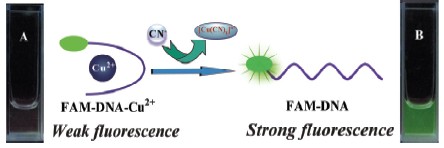| [1] Vennesland, B.; Comm, E.; Knownles, C.; Westly, J.; Wissing, F. Cyandie in Biology, Academic Press, London, 1981. [2] Young, C.; Tidwell, L.; Anderson, C. Minerals, Metals, and Materials Society, Cyanide: Social, Industrial and Economic Aspects, Warrendale, 2001.[3] (a) Kim, H.; Guo, Z.; Zhu, W.; Yoon, J.; Tian, H. Chem. Soc. Rev. 2011, 40, 79; (b) Lou, X.; Ou, D.; Li, Q.; Li, Z. Chem. Commun. 2012, DOI: 10.1039/c2cc33158f; (c) Xu, S.; Liu, B.; Tian, H. Prog. Chem. 2006, 18, 687. (许胜, 刘斌, 田禾, 化学进展, 2006, 18, 687.)[4] Anzenbacher, P.; Tayson, D. S.; Jursíkov, K.; Castellano, F. N. J. Am. Chem. Soc. 2002, 124, 6232.[5] Badugu, R.; Lakowicz, J. R.; Geddes, C. D. J. Am. Chem. Soc. 2005, 127, 3635. [6] Todd, W.; Gabba, F. P. J. Am. Chem. Soc. 2007, 129, 11978.[7] (a) Cho, D. G.; Kim, H.-J.; Sessler, J. L. J. Am. Chem. Soc. 2008, 130, 12163; (b) Sessler, J. L.; Cho, D.-G. Org. Lett. 2008, 10, 73.[8] Jo, J.; Lee, D. J. Am. Chem. Soc. 2009, 131, 16283.[9] (a) Ren, J. Q.; Zhu, W. H.; Tian, H. Talanta 2008, 75, 760; (b) Zou, Q.; Li, X.; Zhang, J.; Zhou, J.; Sun, B.; Tian, H. Chem. Commun. 2012, 48, 2095. [10] Zeng, Q.; Cai, P.; Li, Z.; Qian, J.; Tang, B. Z. Chem. Commun. 2008, 1094. [11] Lou, X. D.; Zhang, L. Y.; Qin, J. G.; Li, Z. Chem. Commun. 2008, 5848. [12] Li, Z. A.; Lou, X. D.; Yu, H. B.; Li, Z.; Qin, J. G. Macromolecules 2008, 41, 7433. [13] Peng, L. H.; Wang, M.; Zhang, G. X.; Zhang, D. Q.; Zhu, D. B. Org. Lett. 2009, 11, 1943. [14] Lou, X. D.; Qin, J. G.; Li, Z. Analyst 2009, 134, 2071. [15] Chen, C. L.; Chen, Y. H.; Chen, C. Y.; Sun, S. S. Org. Lett. 2006, 8, 5053.[16] Yuan, L.; Lin, W. Y.; Yang, Y. T.; Song, J. Z.; Wang, J. L. Org. Lett. 2011, 13, 3730.[17] Dong, M.; Peng, Y.; Dong, Y. M.; Tang, N.; Wang, Y. W. Org. Lett. 2012, 14, 130.[18] Ding, Y. B.; Li, T.; Zhu, W. H.; Xie, Y. S. Org. Biomol. Chem. 2012, 10, 4201.[19] Lou, X. D.; Zeng, Q.; Zhang, Y.; Wan, Z. M.; Qin, J. G.; Li, Z. J. Mater. Chem. 2012, 22, 5581.[20] Li, X. S.; Peng, L. H.; Cui, J. C.; Li, W. N.; Lin, C. X.; Xu, D.; Tian, T.; Zhang, G. X.; Zhang, D. Q.; Li, G. T. Small 2012, 8, 612.[21] (a) Li, J.; Lu, Y. J. Am. Chem. Soc. 2000, 122, 10466; (b) Lee, J. S.; Mirkin, C. A. Anal. Chem. 2008, 80, 6805; (c) Ren, X. S.; Xu, Q. H. Langmuir 2009, 25, 29; (d) Liu, S. J.; Nie, H. G.; Jiang, J. H.; Shen, G. L.; Yu, R. Q. Anal. Chem. 2009, 81, 5724.[22] (a) Brunner, J.; Kraemer, R. J. Am. Chem. Soc. 2004, 126, 13626; (b) Li, C. L.; Liu, K. T.; Lin, Y. W.; Chang, H. T. Anal. Chem. 2011, 83, 225; (c) Shi, L.; Liang, G.; Li, X. H.; Liu, X. H. Anal. Methods 2012, 4, 1036.[23] Hou, P.; Long, Y. F.; Zhao, J.; Wang, J. X.; Zhou, F. M. Spectrochim. Acta Part A 2012, 86, 76.[24] Lin, Z. Z.; Chen, Y.; Li, X. H.; Fang, W. H. Analyst 2011, 136, 2367.[25] Wu, H. W.; Liu, X. P.; Jiang, J. H.; Shen, G. L.; Yu, R. Q. Chin. J. Chem. 2009, 27, 1543. [26] Zou, M.; Liu, S. W.; Zhou, C. Q. Acta Chim. Sinica 2010, 68, 481. (邹敏, 刘叔文, 周春琼, 化学学报, 2010, 68, 481.)Brunner, J.; Kraemer, R. J. Am. Chem. Soc. 2004, 126, 13626. |
